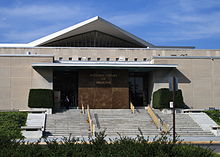W US National Library of Medicine 

Logo: US National Library of Medicine
Entrance to the NLM

The United States National Library of Medicine (NLM),  operated by the United States federal government, is the world's largest medical library. Located in Bethesda, Maryland, the NLM is a division of the National Institutes of Health. Its collections include more than seven million books, journals, technical reports, manuscripts, microfilms, photographs, and images on medicine and related sciences including some of the world's oldest and rarest works The current director of the NLM, since 1984, is Donald A.B. Lindberg. operated by the United States federal government, is the world's largest medical library. Located in Bethesda, Maryland, the NLM is a division of the National Institutes of Health. Its collections include more than seven million books, journals, technical reports, manuscripts, microfilms, photographs, and images on medicine and related sciences including some of the world's oldest and rarest works The current director of the NLM, since 1984, is Donald A.B. Lindberg.
"Dr. Donald A.B. Lindberg Retires Serves National Library of Medicine for 30 Years
November 6, 2014
Don Lindberg, M.D., who has been the director of the National Library of Medicine for more than 30 years, has informed me that he plans to retire at the end of March 2015. I want to thank Don for his outstanding service to NIH, to the global biomedical research community, and to health professionals, patients, and the public. Trained as a pathologist, Don re-invented himself as an expert and groundbreaking innovator in the world of information technology, artificial intelligence, computer-aided medical diagnosis, and electronic health records. ..." Don Lindberg, Director of the National Library of Medicine for 30+ Years, Plans to Retire at the End of March 2015 
PubMed, Index Medicus, and NCBI
Since 1879, the NLM has published the Index Medicus, a monthly guide to articles in nearly five thousand selected journals. The last issue of Index Medicus was printed in December 2004, but this information is offered in the freely accessible PubMed amongst the more than fifteen million MEDLINE journal article references and abstracts going back to the 1960s and 1.5 million references going back to the 1950s. The NLM also runs the National Center for Biotechnology Information (NCBI), which houses biological databases (PubMed among them) that are freely accessible on the Internet through the Entrez search engine.
Toxicology and Environmental Health Program
The Toxicology and Environmental Health Program was established at the NLM in 1967 and is charged with developing computer databases compiled from the medical literature and from the files of governmental and nongovernmental organizations. The program has implemented several information systems for chemical emergency response and public education, such as the Toxicology Data Network (TOXNET), TOXMAP, Tox Town, Wireless Information System for Emergency Responders (WISER), Toxmystery, and the Household Products Database. These resources are accessible without charge on the Web.
Radiation Exposure
The United States National Library of Medicine Radiation Emergency Management System (REMM) provides: Guidance for health care providers, primarily physicians, about clinical diagnosis and treatment of radiation injury during radiological and nuclear emergencies Just-in-time, evidence-based, usable information with sufficient background and context to make complex issues understandable to those without formal radiation medicine expertise Web-based information that can be downloaded in advance, so that it would be available during an emergency if the internet is not accessible.
REMM is produced by the United States Department of Health and Human Services, Office of the Assistant Secretary for Preparedness and Response, Office of Planning and Emergency Operations, in cooperation with the National Library of Medicine, Division of Specialized Information Services, with subject matter experts from the National Cancer Institute, the Centers for Disease Control and Prevention, and many US and international consultants.
Extramural Division
The Extramural Division provides grants to support research in medical information science and to support planning and development of computer and communications systems in medical institutions. Research, publications, and exhibitions on the history of medicine and the life sciences are also supported by the History of Medicine Division. In April 2008 the current exhibition Against the Odds: Making a Difference in Global Health was launched.
History
...The precursor of the NLM, established in 1836, was the Library of the Surgeon General's Office, a part of the office of the Surgeon General of the United States Army. The Armed Forces Institute of Pathology and its Medical Museum were founded in 1862 as the Army Medical Museum. Throughout their history the Library of the Surgeon General's Office and the Army Medical Museum often shared quarters. From 1866 to 1887, they were housed in Ford's Theatre after production there was stopped after the assassination of President Abraham Lincoln.
In 1956, the library collection was transferred from the control of the U.S. Department of Defense to the Public Health Service of the Department of Health, Education and Welfare and renamed the National Library of Medicine, through the instrumentality of Frank Bradway Rogers, who was the Director from 1956 to 1963. The library moved to its current quarters in Bethesda, Maryland, on the campus of the National Institutes of Health, in 1962.
|